
You probably already know that there are many types of dermatitis. We may mention atopic dermatitis the most because it is quite common, but who says it is the only one?
Perioral dermatitis, or correctly oral dermatitis in Slovenian, is also a relatively common skin disorder. As the name suggests, "oral", dermatitis is located somewhere around the mouth. More specifically, it is located between the fold between the nose and mouth and the chin. It is characterized by eruptions in the form of small pink papules and pustules, sometimes with small scales.

It mostly occurs in young and middle-aged women, between the ages of 20 and 45. The male population is only affected by 10%. The disease can have a negative impact on women's self-image, as during outbreaks of dermatitis it cannot be hidden with powder and remains visible.
Treatment
It usually occurs in individuals who have rosacea and are also treated as rosacea. Doctors usually prescribe metronidazole, azelaic acid cream, benzyl peroxide, and may also prescribe clindamycin, erythromycin, tetracycline, or pimecrolimus in cream or gel form.
Factors that cause perioral dermatitis
Overuse of topical corticosteroids can lead to dermatitis, as can the use of corticosteroid sprays for the nose or mouth. Also, toothpaste with fluoride, excessive use of heavy face creams (especially those with a paraffin base and isopropyl myristate). External factors that worsen the disorder include ultraviolet light, heat, and wind.

Can oral dermatitis be confused with another skin disorder?
Yes, and there are quite a few of them. The area around the mouth can be affected by seborrheic dermatitis, rosacea, acne vulgaris, contact dermatitis, lupus erythematosus, and others. However, they all have certain characteristics that set them apart from perioral dermatitis.
Discontinuation of corticosteroids and consequences
First, it is necessary to stop using corticosteroids, as well as cosmetic products such as soaps, moisturizers, scrubs, night and day creams. The individual can only use lukewarm water, neutral creams and compresses made from saline solution or chamomile tea. Psychological support is necessary, as deterioration is expected after stopping the use of corticosteroids. In most cases, the condition begins to improve slowly, and the healing process can last for several weeks, most often around 6 weeks. However, if the condition does not improve after stopping the use of corticosteroids and cosmetic products, we can resort to prescription or natural treatment. When none of these solutions work, it is recommended to use corticosteroids again, but gradually discontinue them. This means that the interval between applying corticosteroids is increasing.
Alternative care instead of treatment
Cold compresses 2 times a day for 15 minutes. Soak gauze in saline solution or soak it in boiled and cooled water. When outbreaks occur, apply our ZincBalm or AtopicBalm to the areas where you have oral dermatitis, and later nourish with AtopicCream 2 times a day. For washing your face, you can try our Oil Shower Gel, which is really gentle on the skin and does not irritate it.
How can we help ourselves?
Oral dermatitis is usually worsened by rapid changes in temperature and external factors. These include wind, sun exposure, heat, and steam. Avoid cosmetics based on mineral oil and isopropyl myristate, alcohol, irritating facial cleansers, and other cosmetics that can further irritate the skin. Avoiding alcohol, coffee, and cocoa may also help.
Lipozencic, J, Ljubojevic, S. Perioral dermatitis. Clinics in Dermatology. 2011:29(2);157–161.
Tempark, T, Shwayder TA. Perioral Dermatitis: A Review of the Condition with Special Attention to Treatment Options. American Journal of Clinical Dermatology. 2014:15(2); 101–113.


